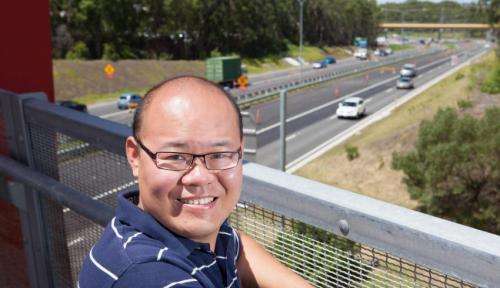Making our highways safer and more efficient

All over the world, gridlock, stop and go driving and constant and sometimes dangerous lane changes are a daily frustration for highway motorists.
However, new research by Dr Xiaobo Qu from Griffith University in Queensland, Australia, in collaboration with Dr Shuaian Wang from Old Dominion University, USA, may provide the means to improving traffic safety, capacity and efficiency between cities.
Dr Qu and Dr Wang have used the M1 Motorway between Queensland's two biggest cities—Gold Coast and Brisbane—as the basis for computer modelling assessing the viability of a Long Distance Commuter lane (LDC).
"Because so many people live on the Gold Coast and work in Brisbane, a large proportion of M1 commuters travel during morning and evening peaks," says Dr Qu.
"At these times, each lane of the M1 carries up to 2300 vehicles every hour and bottlenecks are common.
"However, this modelling demonstrates that a dedicated LDC lane, with not only maximum but also minimum speed limits, could accommodate much higher traffic volume - up to 3000 vehicles per hour—by eliminating or at least minimising disturbances currently caused by lane changing, low speed vehicles and use of on-ramps and off-ramps.
Dr Qu says that in Australia the right-hand lane of the highway - inbound and outbound—could be dedicated to only those commuters travelling the full distance between two cities, or at least the extent of the LDC lane. In the US and most of Europe, the left-hand lane would apply.
"It's a similar implementation to the T2 and T3 systems operating in Australia, although whereas they are geared towards reducing traffic congestion by encouraging car pooling, the LDC lane is about achieving more efficient highway use and management," he says.
"With sufficient demand, an LDC lane would always run at capacity or near-capacity, would have no significant effect on the capacities of other lanes, but could improve traffic management, reduce travel times and enhance driver safety."
Dr Qu believes the LDC concept has potential for commuter travel between other cities in Australia and throughout the world.
"While the Gold Coast and Brisbane are major cities in Australia, the demand only becomes saturated under peak hours. In Europe and the US, where there is a higher demand between major cities, the impact of the LDC lane could be even more pronounced and positive."
The research is published in the journal Computer-Aided Civil and Infrastructure Engineering and another relevant work is published by Transportation Research Part B.
More information: — onlinelibrary.wiley.com/doi/10 … 1111/mice.12102/full
Provided by Griffith University




















